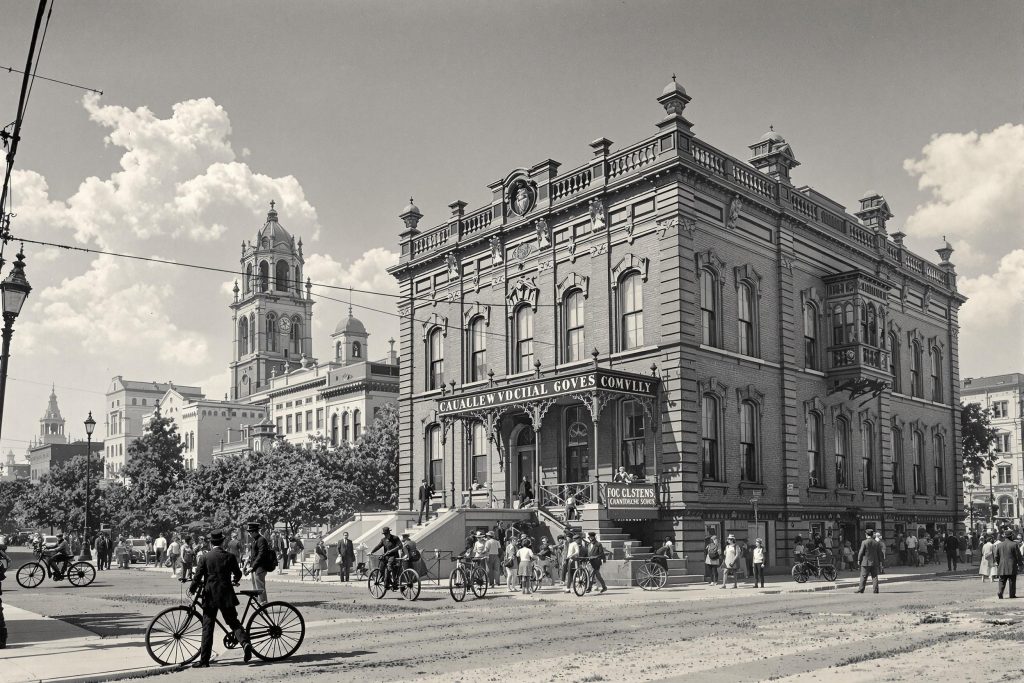
In 1910, a horrific lynching took place in the heart of downtown Dallas. A Black man named Allen Brooks, accused of a crime without due process, was brutally murdered by a white mob. They hanged him from a decorative arch that said, chillingly, “Welcome Visitors.” Thousands of people watched. Some took photos. Some took souvenirs.
It’s a shameful chapter—but an important one to remember. Dallas, like many American cities, carries the weight of racial injustice in its past.
The 1930s brought the East Texas oil boom, and with it, a flood of money and new business. Though the oil wells were 100 miles away, Dallas became the financial center for the industry. Banks, developers, and entrepreneurs made their fortunes here.
Then came World War II, and Dallas stepped up again—this time as a major manufacturer of military vehicles and aircraft. At one plant alone, more than 94,000 jeeps were built for the war effort. At another, North American Aviation produced legendary aircraft like the P-51 Mustang and B-24 Liberator.
Everything changed—again—on a sunny afternoon in 1963, when President John F. Kennedy was assassinated while riding in a motorcade through Dealey Plaza. The country was shattered. So was Dallas. For years, the city bore the weight of that moment, the sense that something irreparable had happened here. Today, the Sixth Floor Museum stands as a solemn reminder.
The decades that followed saw a transformation. Dallas became known for its bold skyline, its booming economy, and its ever-growing cultural diversity. Neighborhoods like Little Mexico became hubs for immigrants seeking a better life, drawn by opportunity and hope.
But not all progress came peacefully. In 2016, during a Black Lives Matter protest downtown, a gunman targeted police officers, killing five. It was the deadliest day for law enforcement since 9/11—a painful reminder of the country’s ongoing struggles with race, violence, and justice. The shooting happened just blocks from where JFK was killed, linking two moments of national grief in one city.
Today, Dallas is one of the most dynamic cities in the country. It’s a hub for technology, finance, art, food, sports, and innovation. People from around the world live and work here. It’s a city of contrasts—old and new, pain and pride, struggle and strength.
It’s not perfect. No city is. But Dallas has a way of reinventing itself. And if you look closely, you can still see traces of every era—every hand that helped build it, every soul that shaped it, every voice that challenged it to be better.
Before there were highways and skyscrapers, before the Cowboys and corporations, the land that would become Dallas was home to the Caddo, Tawakoni, Wichita, Kickapoo, and Comanche peoples. They lived off the rivers and the prairie, trading and traveling long before European settlers arrived. Their legacy is woven into the very soil, even if it’s too often overlooked in the city’s story.
In the 1700s, Spain claimed the region as part of its North American empire. France made its own claim later on, but never followed through with lasting settlements. Eventually, Mexico took control after gaining independence from Spain in 1821.
Over the years, six different flags flew over what we now call Dallas: Spain, France, Mexico, the Republic of Texas, the Confederate States, and finally, the United States. Each left its own mark, for better or worse.
The land officially became part of the U.S. in 1845, following Texas’ annexation. But a few years before that, a man named John Neely Bryan staked his claim on a bluff near the three forks of the Trinity River. He saw the potential for a trading post—close to Native American trails, a river crossing, and rich land. He came back in 1841 and started what would grow into the city of Dallas.
Ask ten people why Dallas is called Dallas, and you’ll get ten different answers. Some say it was named after George Mifflin Dallas, a U.S. Vice President. Others think it was his brother, or maybe even a town in Scotland. Truth is, no one knows for sure. But like much of Texas history, the myth is part of the magic.
Dallas didn’t have a river port or a coastline—but what it did have was ambition. When the railroads arrived in the late 1800s, they turned Dallas into a booming business hub almost overnight. Cotton, cattle, banking, and eventually oil—everything moved through Dallas.
In 1855, a group of French Socialists tried to build a utopian community called La Réunion on the outskirts of town. It didn’t last, but it brought artists, teachers, and thinkers who helped shape the city’s culture in subtle ways.
By the early 1900s, Dallas was home to one of the first skyscrapers west of the Mississippi—the Praetorian Building, all 15 stories of it. The city had arrived.
But this prosperity wasn’t shared equally.

HERE Dallas strives to provide the finest deals, products, and experiences in your local community. It’s all RIGHT HERE, and it’s all LOCAL.
If you notice something that you believe should be here, please let us know. And you’ll notice it soon HERE!
© Copyright 2025, HERECity.com